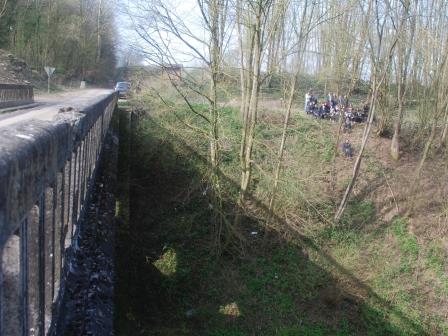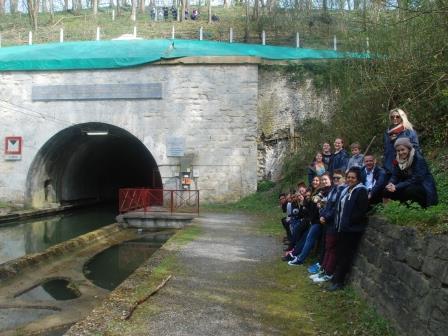April 13th
Day 7 13th April Amiens – Bellicourt – Bullecourt – Arras
Today was a huge day with many kilometres covered and plenty of history to be explored. From Amiens we travelled along the Somme following the path that Australian soldiers took as they fought their way from the Battle of Amiens on the 8th August 1918 to their final actions of the war near Bellicourt and the Hindenburg Line. Before reaching Bellicourt we stopped at the Recquival Bridge which is the scene of a famous photo showing victorious soldiers lining the steep banks of the St. Quentin Canal while being addressed by their officers from the bridge. As we struggled to recapture that moment and recreate the image, three Frenchmen appeared, also interested in the wartime history of the area. Thanks to Jackie’s French and with plenty of photographs taken during the war, they were able to explain more about the bridge and the canal which it crosses. We then walked along the banks of the canal to the tunnel which runs under the village of Bellicourt. Both the canal and the tunnel were built by hand using convict labour under the rule of Napolean Bonaparte in the early 1800’s. An amazing engineering feat, this canal was integrated into the defensive line known as the Hindenburg Line. We then made our way to Bellicourt and 2 soldiers were commemorated here. We also visited the site of the capture of the 77mm Krupp Field Gun that now stands in the Memorial Park in Meningie.
We then headed toward Bullecourt. On the way we stopped to see the 4th Divisional Memorial at Bellenglise and Tincourt Military Cemetery where Julie told of us of our promise to take a photo of a grave for a couple in Australia who have made contact with us only through email. Another quick stop at Mt. St. Quentin to see the 2nd Divisional Memorial and on to the Digger Memorial at Bullecourt. This was the site of 2 battles in April – May 2017 that cost Australia 10,000 casualties. We had lunch on the lawns here and commemorated another soldier. Some of us went relic hunting in the paddock next door and quickly turned up a number of pieces of shrapnel, some almost a kilogram in weight, still remaining from World War 1. Further north we commemorated another soldier at the Ballieul Rd Cemetery before making our way to Notre Dame De Lorette which is a massive French Cemetery and Ossary. Since our last visit a new memorial has been built there. From there it was on to our new home for 2 days, Arras.
Mal Jurgs
Today we visited for the first time the new memorial at Notre Dame de Lorette which lists the names, in alphabetical order, with no distinction of which side or for which country they fought, of the 570000+ people who died in the Pas-de-Calais and Nord regions of France. That doesn’t include all of the Somme, Belgium, Verdun, Chemin des Dames etc, just Nord and Pas de Calais. For us Australians that means Fromelles, Bullecourt and a few other lesser battles plus the soldiers and nurses who died in the hospitals at Etaples and others along that coastline. To see those names in one place is staggering. It is an amazing gesture on the part of the French to include the names of the Germans as well, and beautifully and serenely illustrates the massive losses that were felt by everyone caught up in this conflagration. After 5 trips to the Western Front, looking in every German Cemetery we visited, trying to find the name Jurgs, today was the first time that I have seen it in print on a memorial anywhere. I know that there were 20 or more Jurgs’ killed in WW1 on the German side and that they are most likely all reasonably closely related to me, but I was not prepared for the hit of emotion that I got when I saw those names. One was Heinrich Jurgs, the same name as my great grandfather who came to Australia in the 1850’s, the other was Peter Heinrich Wilhelm Jurgs, all names that occur throughout my family tree. Earlier in the day I commemorated my Great Uncle Frank who was killed by a shell fired from a German gun, killed by the same army that these two men, possibly my grandfather’s 1st or 2nd cousins, died fighting for. The journey I have been on since starting Connecting Spirits has been confronting, confusing, fascinating, emotional, and at times frustrating, but this has heightened all of those thoughts inside of me.
Nigel Treloar
Bullecourt - Arras. At the Diggers memorial, it was peaceful, the memory of the diggers for what they did for our country. Day 8 Wellington tunnels. Went under ground more then 10 meters, it was cold and very humid. It would of been terrifying hearing just things exploding, knowing that anything could happen so fast so quick and you had to live life on the edge.















